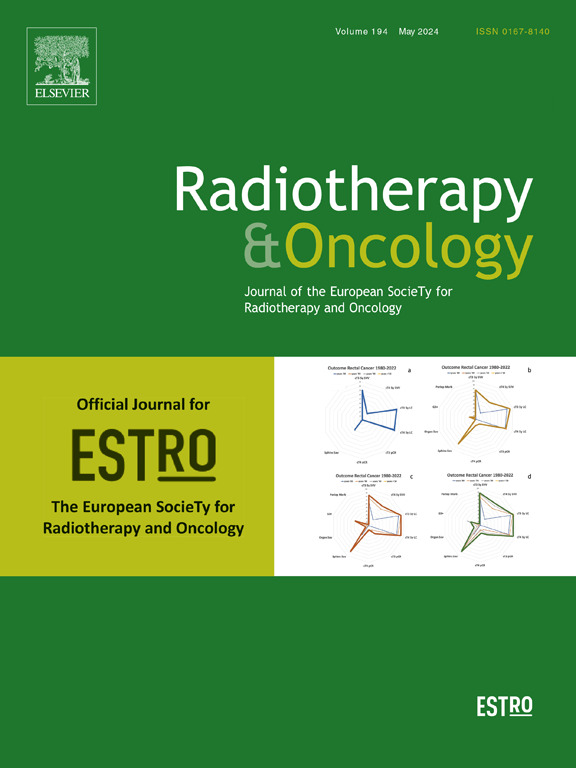Clinical experience with free-breathing expiration-gated 10MV FFF VMAT stereotactic lung radiotherapy
IF 4.9
1区 医学
Q1 ONCOLOGY
引用次数: 0
Abstract
Background
Free-breathing expiration-gating (EG) is a non-invasive technique used to manage respiratory-induced tumor motion. This study explores the effectiveness of EG stereotactic body radiotherapy (SBRT) for lung tumors using 10MV FFF VMAT.
Methods and Materials
The study included 41 patients (50 targets) treated with EG lung SBRT between September 2019 and February 2023. Patients underwent free-breathing uncoached 10-phase 4DCT for planning, with the choice for EG based on e.g. tumor motion, critical organ dose, expected target visibility on free-breathing CBCT, taking into account suitability of the breathing pattern. The gating window was typically set at phases 30–70 % of the breathing cycle. Treatment planning utilized VMAT with 10MV FFF, and tumor motion was monitored using EG-CBCT ± near real-time markerless kV imaging. Treatment times for the different parts of treatment, tumor stability and clinical outcomes were evaluated. Dosimetric outcomes were compared between EG and free-breathing plans for a subset of 10 patients.
Results
EG SBRT substantially reduced longitudinal tumor motion and internal target volume (ITV) by 77 % and 42 % respectively. There was a mean decrease of 21/24 % in V5/V20Gy for the ipsilateral lung. Motion monitoring during treatment for 20 targets showed that intrafraction tumor motion remained within 2 mm for most patients, ensuring accurate dose delivery. 86 % of fractions were completed within 25 min. No local recurrences were observed during a median follow-up of 13 months.
Conclusion
Free-breathing EG SBRT is a feasible, effective, and practical approach for lung cancer treatment, offering significant reductions in tumor motion and lung doses while maintaining high treatment accuracy and acceptable treatment times.
求助全文
约1分钟内获得全文
求助全文
来源期刊

Radiotherapy and Oncology
医学-核医学
CiteScore
10.30
自引率
10.50%
发文量
2445
审稿时长
45 days
期刊介绍:
Radiotherapy and Oncology publishes papers describing original research as well as review articles. It covers areas of interest relating to radiation oncology. This includes: clinical radiotherapy, combined modality treatment, translational studies, epidemiological outcomes, imaging, dosimetry, and radiation therapy planning, experimental work in radiobiology, chemobiology, hyperthermia and tumour biology, as well as data science in radiation oncology and physics aspects relevant to oncology.Papers on more general aspects of interest to the radiation oncologist including chemotherapy, surgery and immunology are also published.
 求助内容:
求助内容: 应助结果提醒方式:
应助结果提醒方式:


